Fuzzy Adaptive PSO-ELM Algorithm Applied to Vehicle Sound Quality Prediction
Abstract
:1. Introduction
- (1)
- Short learning time. ELM does not need to set the network weights; the hidden layer weights and threshold values are obtained in a random way, so the learning rate is very fast.
- (2)
- Simple algorithm implementation. It can be computed quickly by simply setting the network structure parameters.
- (3)
- Strong generalization ability. The general neural network training process is prone to the phenomenon of “overfitting”, but ELM has a strong generalization ability.
2. Fuzzy Adaptive PSO-ELM Prediction Model
2.1. Extreme Learning Machine
2.2. Fuzzy Adaptive Particle Swarm Optimization
3. Subjective and Objective Evaluation Models of Sound Quality
3.1. Objective Evaluation Parameters of Sound Quality
3.2. Subjective Evaluation Test of Sound Quality
4. Application of Sound Quality Prediction Model
- First step:
- Second step:
- Third step:
- Fourth step:
- Fifth step:
- Sixth step:
5. Prediction Result
6. Conclusions
Author Contributions
Funding
Institutional Review Board Statement
Informed Consent Statement
Data Availability Statement
Conflicts of Interest
References
- Geng, Y.T.; Nakayama, M.; Nishiura, T. Demodulated sound quality improvement for harmonic sounds in over-boosted parametric array loudspeaker. Appl. Acoust. 2022, 186, 108460. [Google Scholar] [CrossRef]
- Wang, X.L.; Song, Y.C.; Liu, N.N. Hybrid vibro-acoustic active control method for vehicle interior sound quality under high-speed. Appl. Acoust. 2022, 186, 108419. [Google Scholar] [CrossRef]
- Liu, Z.E.; Li, X.L.; Zheng, Q.Q. Strategy and implementing techniques for the sound quality target of car interior noise during acceleration. Appl. Acoust. 2021, 182, 108171. [Google Scholar] [CrossRef]
- Shang, Z.H.; Hu, F.; Wang, J.S. Research of transfer path analysis based on contribution factor of sound quality. Appl. Acoust. 2021, 173, 107693. [Google Scholar] [CrossRef]
- Lin, J.W.; Zhang, R.; Lin, G.Y. Research on Tone Quality for Vehicles Considering the Masking Effect. In Proceedings of the ASME International Mechanical Engineering Congress and Exposition, Virtual, 1–5 November 2021; American Society of Mechanical Engineers: New York, NY, USA, 2021; Volume 85543, p. V001T01A023. [Google Scholar]
- Zhang, E.L.; Hou, L.; Zhang, Y.X. Sound quality prediction of vehicle interior noise and mathematical modeling using a back propagation neural network (BPNN) based on particle swarm optimization (PSO). Meas. Sci. Technol. 2016, 27, 015801. [Google Scholar] [CrossRef]
- Liu, N.; Li, W.; Guo, H. Comparative analysis for subjective evaluation method of sound quality. Mod. Manuf. Eng. 2016, 10, 6–11. [Google Scholar]
- Buss, S.; Schulte-Fortkamp, B.; Muckel, P. Combining methods to evaluate sound quality. In Proceedings of the 29th International Congress and Exposition on Noise Control Engineering (Inter-Noise 2000), Nice, France, 27–30 August 2000; pp. 27–30. [Google Scholar]
- Shimizu, S.; Kajikawa, Y. A sound quality customization system using paired comparison. In Proceedings of the 2009 17th European Signal Processing Conference, Glasgow, UK, 24–28 August 2009; IEEE: Piscataway, NJ, USA, 2009; pp. 185–188. [Google Scholar]
- Xie, L.P.; Lu, C.H.; Xu, T. Study of Electroencephalograph-Based Evaluation Method of Car Sound Quality. J. Comput. Inf. Sci. Eng. 2023, 23, 021011. [Google Scholar] [CrossRef]
- Bodden, M.; Heinrichs, R.; Linow, A. Sound quality evaluation of interior vehicle noise using an efficient psychoacoustic method. In Proceedings of the 3rd European Conference on Noise Control-Euronoise, Munich, Germany, 4–7 October 1998; Volume 98, pp. 609–614. [Google Scholar]
- Kavarana, F.; Taschuk, G.; Schiller, T.; Bogema, D. An Efficient Approach to Improving Vehicle Acceleration Sound Quality Using an NVH Simulator; SAE Technical Paper; SAE International: Warrendale, PA, USA, 2009. [Google Scholar]
- Tan, G.P.; Wang, D.F.; Li, Q. Vehicle interior sound quality prediction based on back propagation neural network. Procedia Environ. Sci. 2011, 11, 471–477. [Google Scholar] [CrossRef]
- Huang, H.B.; Wu, J.H.; Ding, W.P. Pure electric vehicle nonstationary interior sound quality prediction based on deep CNNs with an adaptable learning rate tree. Mech. Syst. Signal Process. 2021, 148, 107170. [Google Scholar] [CrossRef]
- Song, X.D.; Yang, W. Research on the Sound Quality Evaluation Method Based on Artificial Neural Network. Sci. Program. 2022, 2022, 8686785. [Google Scholar] [CrossRef]
- Xiong, T.; Bao, Y.K.; Chiong, R. Forecasting interval time series using a fully complex-valued RBF neural network with DPSO and PSO algorithms. Inf. Sci. 2015, 305, 77–92. [Google Scholar] [CrossRef]
- Chen, P.S.; Xu, L.Y.; Liu, W. Research on prediction model of tractor sound quality based on genetic algorithm. Appl. Acoust. 2022, 185, 108411. [Google Scholar] [CrossRef]
- Huang, X.R.; Huang, H.B.; Ding, W.P. Sound quality prediction and improving of vehicle interior noise based on deep convolutional neural networks. Expert Syst. Appl. 2020, 160, 113657. [Google Scholar] [CrossRef]
- Lee, H.; Lee, J. Neural network prediction of sound quality via domain Knowledge-Based data augmentation and Bayesian approach with small data sets. Mech. Syst. Signal Process. 2021, 157, 107713. [Google Scholar] [CrossRef]
- Zhang, J.H.; Xia, S.Q.; Tang, H.S. Sound quality evaluation and prediction for the emitted noise of axial piston pumps. Appl. Acoust. 2019, 145, 27–40. [Google Scholar] [CrossRef]
- Zhao, B.; Wu, C.J. Sound quality evaluation of electronic expansion valve using Gaussian restricted Boltzmann machines based DBN. Appl. Acoust. 2020, 170, 107493. [Google Scholar] [CrossRef]
- Pourseiedrezaei, M.; Loghmani, A.; Keshmiri, M. Development of a Sound Quality Evaluation Model Based on an Optimal Analytic Wavelet Transform and an Artificial Neural Network. Arch. Acoust. 2021, 46, 55–65. [Google Scholar]
- Zhang, X.C.; Cheng, J.; Sha, W. Sound quality evaluation of pure electric vehicle with subjective and objective unified evaluation method. Int. J. Veh. Des. 2022, 88, 283–303. [Google Scholar] [CrossRef]
- Huang, H.B.; Huang, X.R.; Ding, W.P. Sound quality prediction of vehicle interior noise using deep belief networks. Appl. Acoust. 2016, 113, 149–161. [Google Scholar] [CrossRef]
- Huang, G.B.; Zhu, Q.Y.; Siew, C.K. Extreme learning machine: Theory and applications. Neurocomputing 2006, 70, 489–501. [Google Scholar] [CrossRef]
- Wang, L.; Khishe, M.; Mahmoodzadeh, A. Extreme learning machine evolved by fuzzified hunger games search for energy and individual thermal comfort optimization. J. Build. Eng. 2022, 60, 105187. [Google Scholar] [CrossRef]
- Liu, Y.; Wang, L.H.; Liu, X.M. Drought prediction based on an improved VMD-OS-QR-ELM model. PLoS ONE 2022, 17, e0262329. [Google Scholar] [CrossRef] [PubMed]
- Jia, Z.Z.; Song, Z.L.; Jiang, J.Y. Prediction of Blasting Fragmentation Based on GWO-ELM. Shock Vib. 2022, 2022, 7385456. [Google Scholar] [CrossRef]
- Jia, Y.; Su, Y.; Zhang, R. Optimization of an extreme learning machine model with the sparrow search algorithm to estimate spring maize evapotranspiration with film mulching in the semiarid regions of China. Comput. Electron. Agric. 2022, 201, 107298. [Google Scholar] [CrossRef]
- Li, C.Q.; Zhou, J.; Qiu, Y.G. Six novel hybrid extreme learning machine–swarm intelligence optimization (ELM–SIO) models for predicting backbreak in open-pit blasting. Nat. Resour. Res. 2022, 31, 3017–3039. [Google Scholar] [CrossRef]
- Anthony, M.; Bartlett, P.L.; Bartlett, P.L. Neural Network Learning: Theoretical Foundations; Cambridge University Press: Cambridge, UK, 1999; ISBN 9780521118620. [Google Scholar]
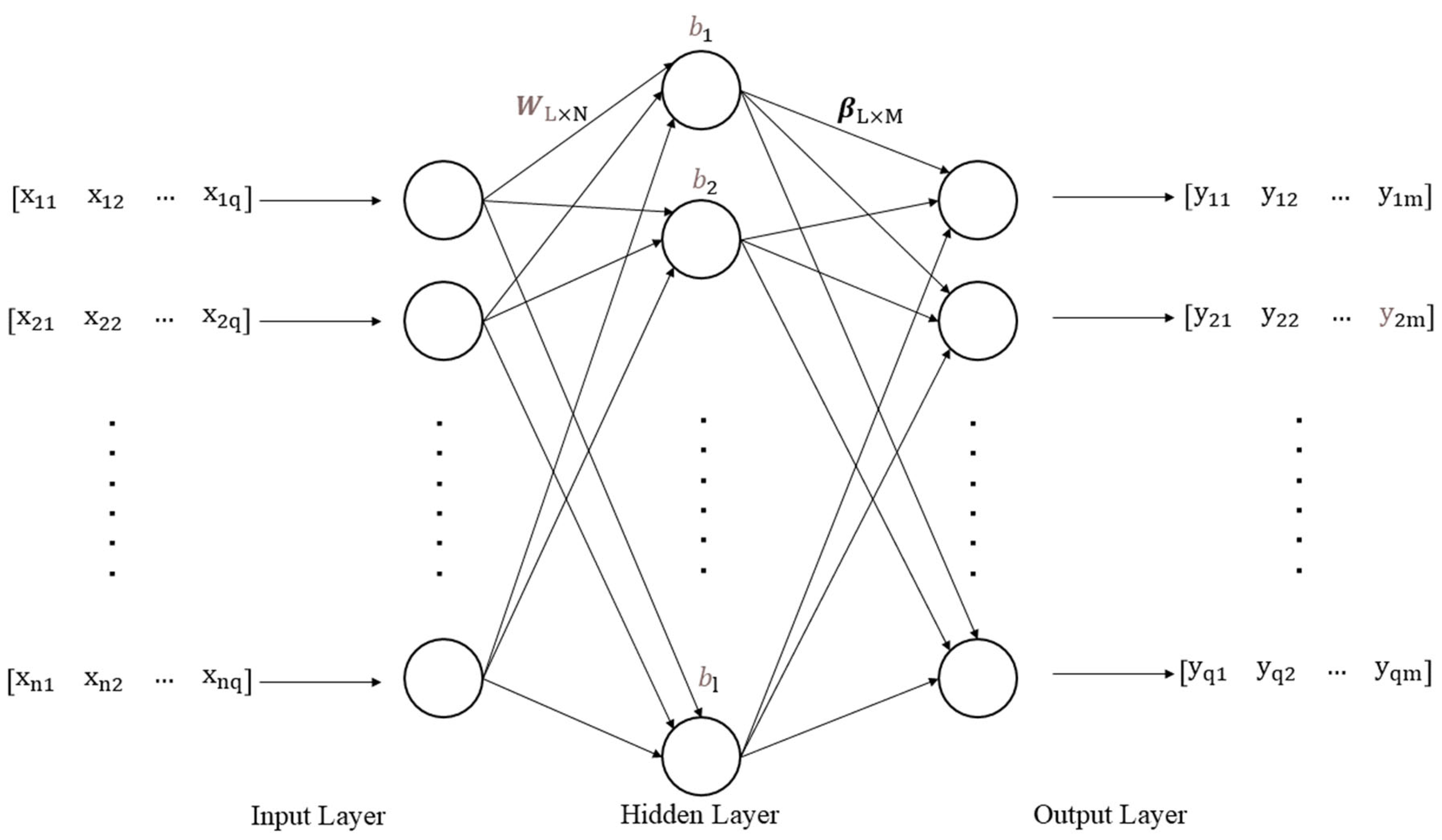
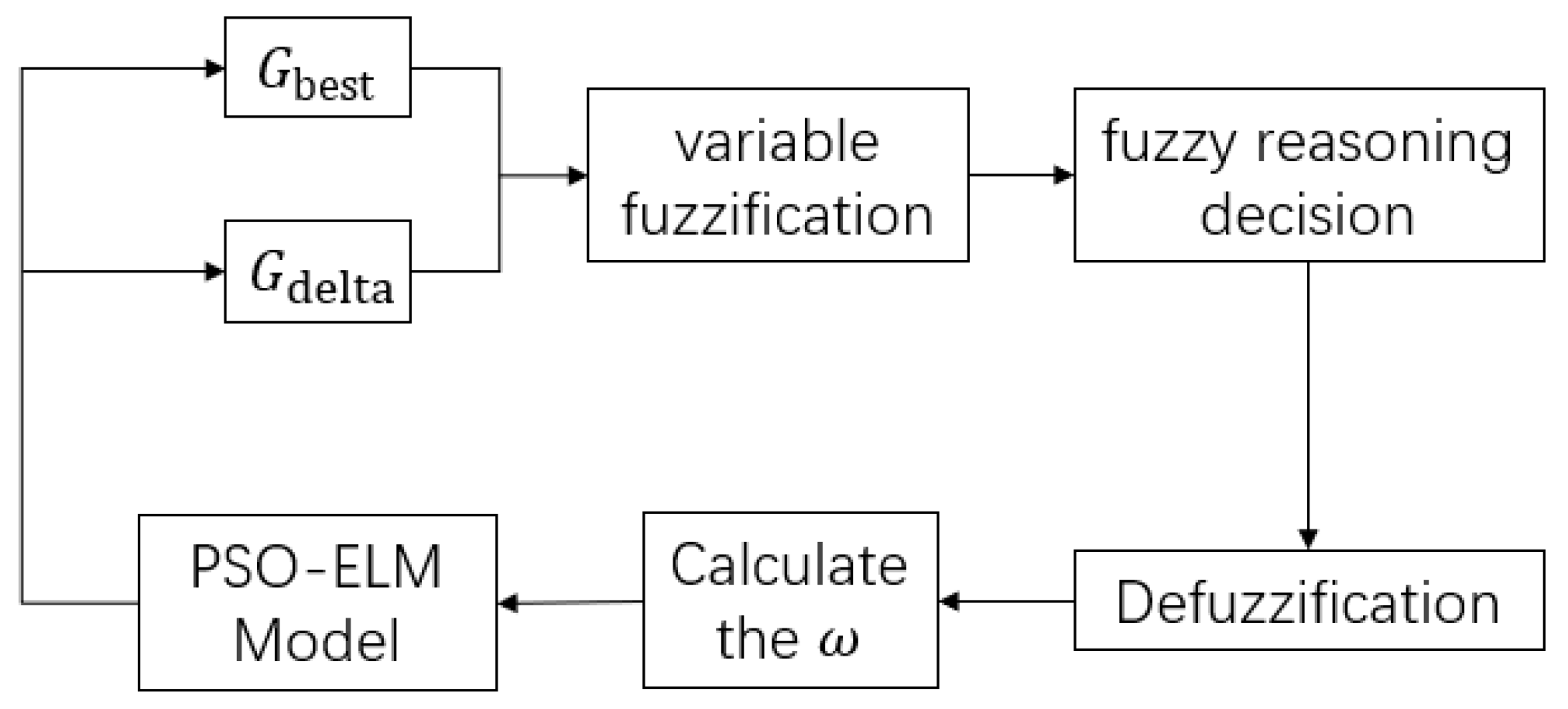
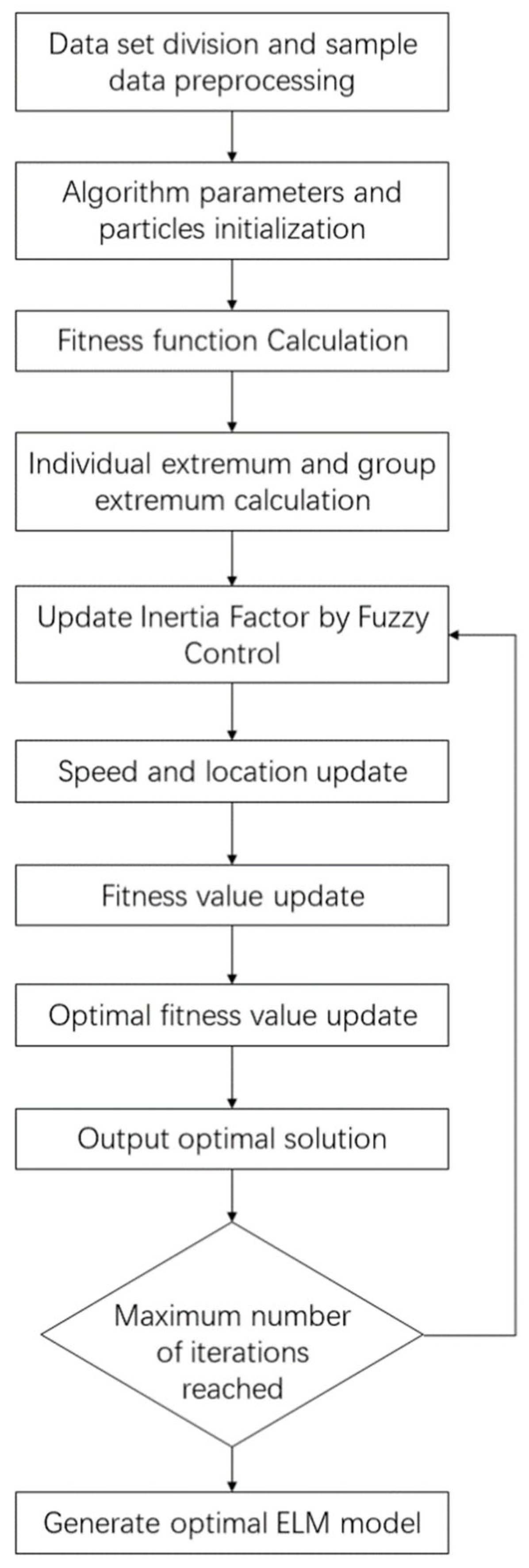
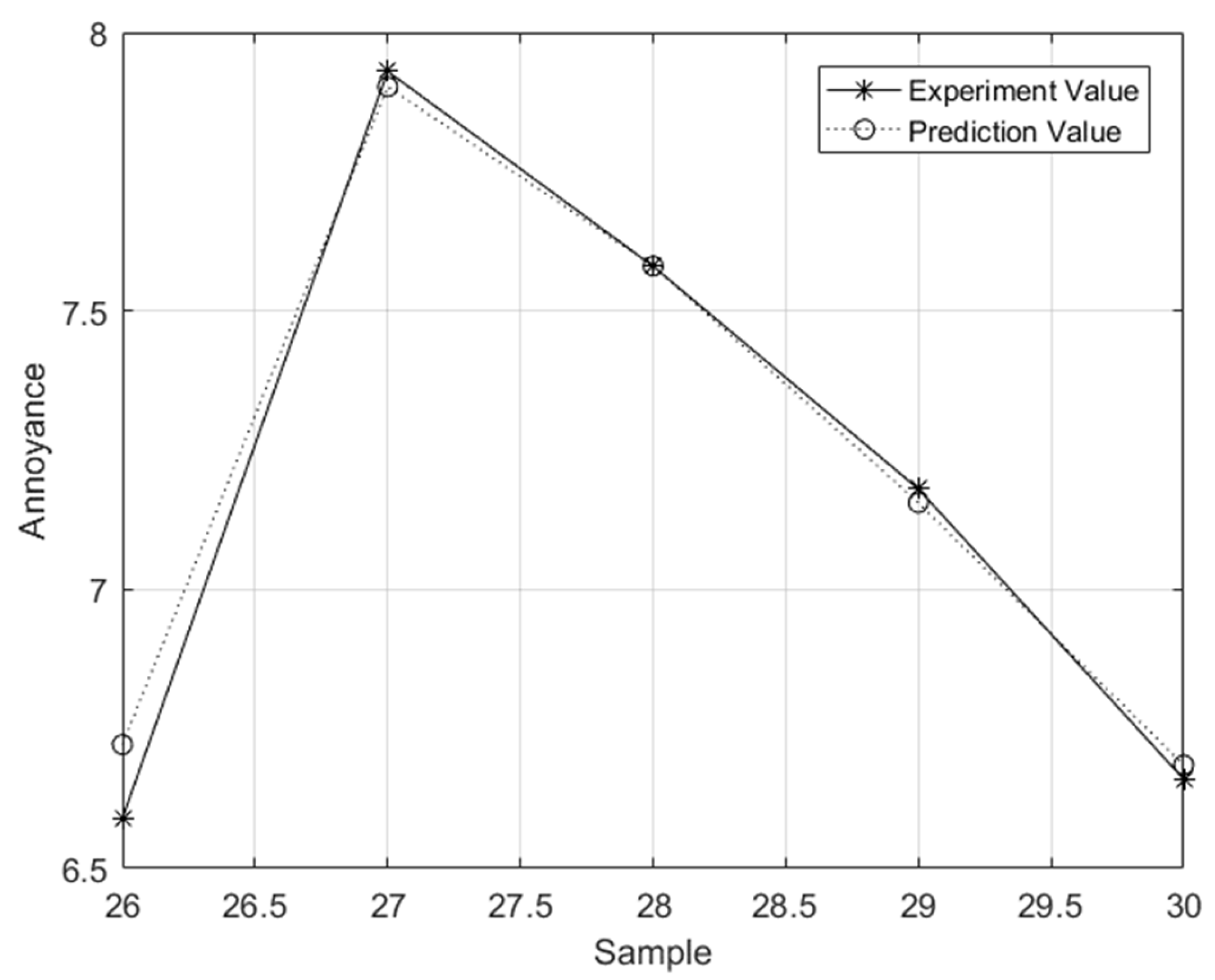
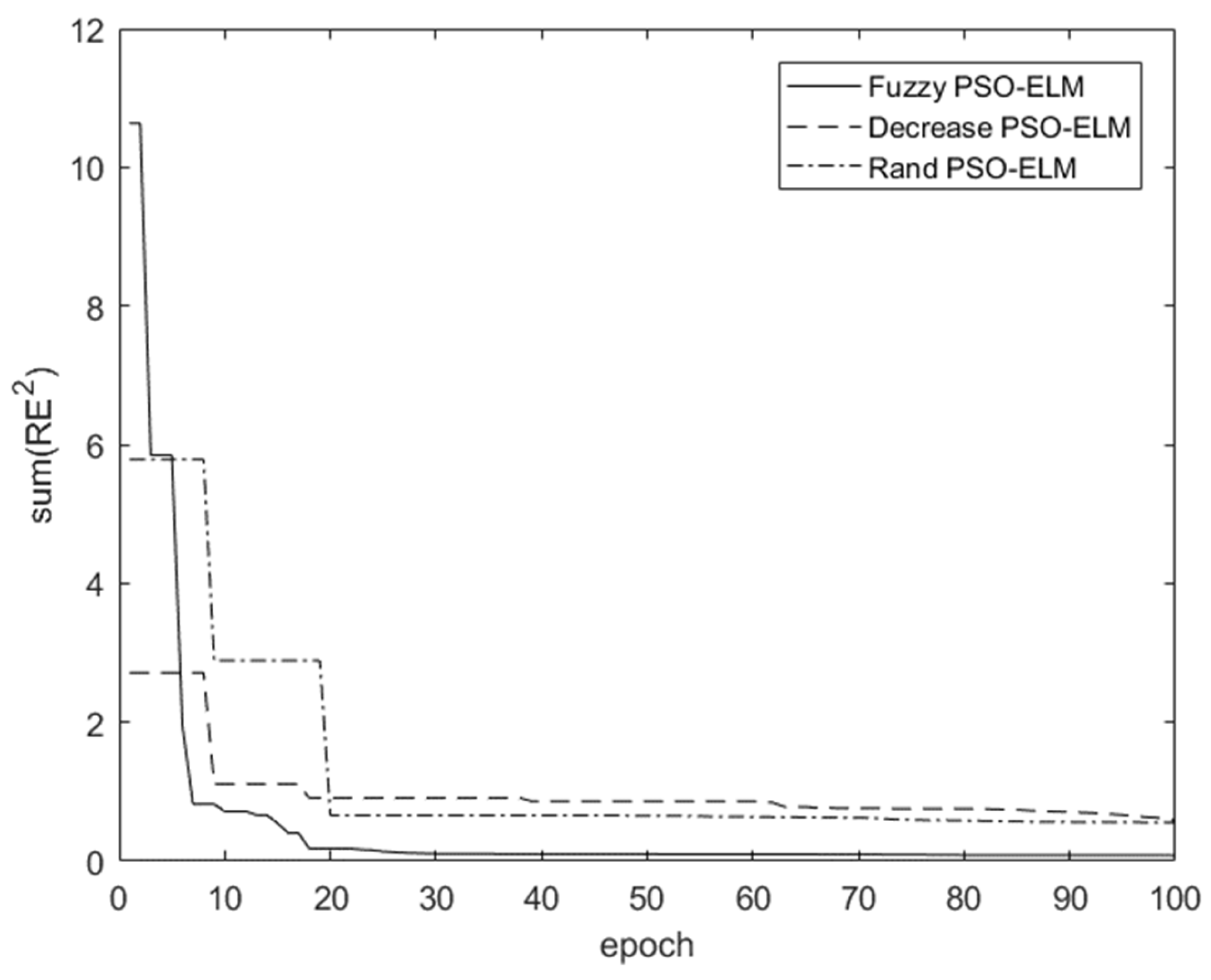
| Very Bad | Bad | Very Poor | Poor | Unsatisfied | Within Accepted | Satisfied | Relatively Good | Good | Very Good | Excellent |
|---|---|---|---|---|---|---|---|---|---|---|
| 1 | 2 | 3 | 4 | 5 | 6 | 7 | 8 | 9 | 10 | 11 |
| Sample | O | |||||
|---|---|---|---|---|---|---|
| A-Sound Pressure/dB | Loudness/Sone | Roughness/Asper | Fluctuation/Vacil | Sharpness/Acum | Comfort | |
| 1 | 61.8 | 14.1 | 0.98 | 0.0435 | 0.88 | 7.76 |
| 2 | 63.2 | 14.3 | 1.11 | 0.0496 | 0.94 | 7.61 |
| 3 | 67.5 | 21.5 | 1.88 | 0.0552 | 1.25 | 6.98 |
| 4 | 71.3 | 26.8 | 2.29 | 0.0627 | 1.52 | 6.21 |
| 5 | 74.2 | 31.6 | 2.68 | 0.0605 | 1.76 | 5.63 |
| 6 | 56.9 | 11.2 | 1.25 | 0.0398 | 0.81 | 7.34 |
| 7 | 60.3 | 13.5 | 1.42 | 0.0412 | 0.91 | 7.51 |
| 8 | 63.5 | 16.9 | 1.79 | 0.0548 | 1.02 | 7.45 |
| 9 | 67.2 | 23.8 | 2.06 | 0.0579 | 1.33 | 6.99 |
| 10 | 70.1 | 29.3 | 2.48 | 0.0654 | 1.63 | 6.03 |
| 11 | 59.1 | 10.8 | 1.36 | 0.0436 | 0.79 | 7.76 |
| 12 | 60.2 | 12.3 | 1.55 | 0.0421 | 0.88 | 8.12 |
| 13 | 65.3 | 18.7 | 1.89 | 0.0451 | 1.07 | 7.61 |
| 14 | 68.1 | 22.2 | 2.18 | 0.0468 | 1.21 | 7.28 |
| 15 | 71.0 | 26.1 | 2.47 | 0.0557 | 1.41 | 6.42 |
| 16 | 55.8 | 9.78 | 0.98 | 0.0386 | 0.67 | 8.61 |
| 17 | 58.7 | 11.1 | 1.05 | 0.0408 | 0.78 | 8.30 |
| 18 | 60.8 | 13.1 | 1.25 | 0.0425 | 0.91 | 7.84 |
| 19 | 63.9 | 17.2 | 1.58 | 0.0442 | 1.04 | 7.47 |
| 20 | 65.8 | 19.5 | 1.73 | 0.0511 | 1.16 | 7.16 |
| 21 | 71.8 | 30.5 | 2.31 | 0.0688 | 1.58 | 6.33 |
| 22 | 64.2 | 20.3 | 1.61 | 0.0532 | 1.27 | 7.03 |
| 23 | 69.6 | 25.1 | 2.45 | 0.0601 | 1.83 | 6.35 |
| 24 | 61.9 | 14.5 | 1.08 | 0.0486 | 1.09 | 7.78 |
| 25 | 61.4 | 15.0 | 0.91 | 0.0502 | 1.08 | 7.77 |
| 26 | 68.5 | 23.9 | 2.03 | 0.0596 | 1.41 | 6.58 |
| 27 | 60.4 | 14.9 | 0.98 | 0.0541 | 1.05 | 7.92 |
| 28 | 62.8 | 15.6 | 1.06 | 0.0459 | 1.13 | 7.57 |
| 29 | 61.2 | 15.4 | 1.83 | 0.0483 | 1.10 | 7.17 |
| 30 | 70.5 | 27.9 | 2.20 | 0.0632 | 1.49 | 6.65 |
| L\Q | N | M | c1\c2 | Vmax | Vmin | Xmax | Xmin | psize | tmax |
|---|---|---|---|---|---|---|---|---|---|
| 25 | 5 | 1 | 2 | 1 | −1 | 1 | −1 | 50 | 100 |
| Gbest/Gdelta | PS | PM | PB |
|---|---|---|---|
| PS | PS | PM | PB |
| PM | PM | PM | PB |
| PB | PB | PB | PB |
| Weight W | Threshold B | |||||
|---|---|---|---|---|---|---|
| Neuron | x1 | x2 | x3 | x4 | x5 | |
| 1 | −1.0000 | 0.8060 | 0.2184 | −0.5430 | −0.4593 | 0.5717 |
| 2 | −0.7257 | 0.5136 | −0.1375 | −0.8186 | 0.6534 | −0.5850 |
| 3 | 0.8079 | 0.1887 | −0.6667 | −0.7134 | −0.1965 | −0.2950 |
| 4 | −0.0917 | −0.4185 | 0.6026 | 0.5062 | 0.3025 | 0.7609 |
| 5 | −1.0000 | −0.4159 | −0.4271 | −0.7316 | −0.7292 | 0.5346 |
| 6 | 0.5776 | 0.2675 | 0.6587 | 1.0000 | 0.0931 | 0.3879 |
| 7 | −0.3125 | 0.3782 | 0.6130 | −0.3669 | −0.4486 | 0.5895 |
| 8 | −0.6616 | 0.4314 | −0.8580 | 0.2665 | −0.9892 | 0.0127 |
| 9 | 0.4088 | 0.7413 | 0.7447 | 0.1476 | −0.1464 | −0.7418 |
| 10 | −0.8033 | 0.6601 | −1.0000 | −0.9385 | 0.4228 | −0.8356 |
| 11 | 0.6458 | 0.8741 | −0.4418 | −0.3638 | 0.1418 | −0.1944 |
| 12 | 0.2965 | −1.0000 | 0.5556 | −0.1569 | 0.0506 | 0.9020 |
| 13 | 0.5784 | 0.0131 | −0.2893 | 1.0000 | 0.1926 | −0.0705 |
| 14 | −0.1129 | −1.0000 | 0.9955 | 0.0501 | −0.4754 | −0.2773 |
| 15 | −0.3985 | 0.6379 | 0.4845 | 0.5791 | −0.7845 | 0.3711 |
| 16 | −0.2696 | −0.6771 | 0.5923 | 0.9903 | 0.9121 | 0.1328 |
| 17 | 0.0146 | −0.0551 | −0.5042 | 0.7369 | −1.0000 | −1.0000 |
| 18 | −0.2424 | 0.5111 | 0.0367 | 0.2273 | −0.4121 | 0.9998 |
| 19 | −0.9926 | 0.8226 | −0.2407 | 0.1981 | 0.5433 | 0.9922 |
| 20 | 0.5401 | 0.5098 | 0.5910 | −0.0447 | −0.3496 | 0.6089 |
| 21 | 0.6670 | 1.0000 | 0.6958 | 0.1366 | 0.9006 | 0.0171 |
| 22 | 0.2018 | 0.5426 | −1.0000 | −0.9980 | 0.4474 | −0.1583 |
| 23 | 1.0000 | −0.2579 | −0.6295 | 0.1239 | −0.1309 | −0.1726 |
| 24 | −0.7790 | −0.5362 | 0.4190 | −0.5983 | −0.2731 | −0.4946 |
| 25 | 0.6844 | 0.1888 | −0.5298 | −0.4650 | −0.3537 | 0.1165 |
| BP Model [6] | GA-BP Model [6] | |||||||||||||||
|---|---|---|---|---|---|---|---|---|---|---|---|---|---|---|---|---|
| Sample | EV | PV | RE% | ARE% | PV | RE% | ARE% | |||||||||
| 26 | 6.59 | 7.0850 | 7.51 | 4.45 | 6.1669 | 6.42 | 3.31 | |||||||||
| 27 | 7.93 | 7.7940 | 1.72 | 8.0010 | 0.89 | |||||||||||
| 28 | 7.58 | 7.4820 | 1.29 | 7.3907 | 2.50 | |||||||||||
| 29 | 7.18 | 7.8832 | 9.79 | 7.4330 | 3.52 | |||||||||||
| 30 | 6.66 | 6.5318 | 1.93 | 6.4450 | 3.23 | |||||||||||
| PSO-BP Model [6] | Fuzzy adaptive PSO-ELM model | |||||||||||||||
| Sample | EV | PV | RE% | ARE% | EV | PV | RE% | ARE% | ||||||||
| 26 | 6.59 | 6.5986 | 0.13 | 1.64 | 6.58 | 6.7221 | 2.160 | 0.73 | ||||||||
| 27 | 7.93 | 7.5992 | 4.17 | 7.92 | 7.9024 | 0.222 | ||||||||||
| 28 | 7.58 | 7.5724 | 0.10 | 7.57 | 7.5703 | 0.004 | ||||||||||
| 29 | 7.18 | 7.3217 | 1.97 | 7.17 | 7.1455 | 0.342 | ||||||||||
| 30 | 6.66 | 6.7810 | 1.82 | 6.65 | 6.7121 | 0.934 | ||||||||||
Disclaimer/Publisher’s Note: The statements, opinions and data contained in all publications are solely those of the individual author(s) and contributor(s) and not of MDPI and/or the editor(s). MDPI and/or the editor(s) disclaim responsibility for any injury to people or property resulting from any ideas, methods, instructions or products referred to in the content. |
© 2023 by the authors. Licensee MDPI, Basel, Switzerland. This article is an open access article distributed under the terms and conditions of the Creative Commons Attribution (CC BY) license (https://creativecommons.org/licenses/by/4.0/).
Share and Cite
Wang, C.; Yang, G.; Li, J.; Huang, Q. Fuzzy Adaptive PSO-ELM Algorithm Applied to Vehicle Sound Quality Prediction. Appl. Sci. 2023, 13, 9561. https://doi.org/10.3390/app13179561
Wang C, Yang G, Li J, Huang Q. Fuzzy Adaptive PSO-ELM Algorithm Applied to Vehicle Sound Quality Prediction. Applied Sciences. 2023; 13(17):9561. https://doi.org/10.3390/app13179561
Chicago/Turabian StyleWang, Chenlin, Gongzhuo Yang, Junyu Li, and Qibai Huang. 2023. "Fuzzy Adaptive PSO-ELM Algorithm Applied to Vehicle Sound Quality Prediction" Applied Sciences 13, no. 17: 9561. https://doi.org/10.3390/app13179561
APA StyleWang, C., Yang, G., Li, J., & Huang, Q. (2023). Fuzzy Adaptive PSO-ELM Algorithm Applied to Vehicle Sound Quality Prediction. Applied Sciences, 13(17), 9561. https://doi.org/10.3390/app13179561






